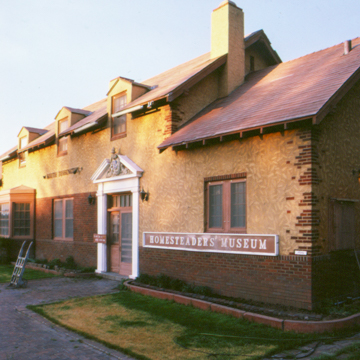You are here
Homesteaders Museum
The South Torrington Union Pacific Depot is located on U.S. Highway 85, about one-half mile south of downtown Torrington, and just south of the North Platte River. The depot was built in 1926, when the Union Pacific completed its “North Platte Cutoff,” creating a direct link on the transcontinental railroad between the Upper North Platte River Valley and Cheyenne. The cutoff reduced the distance between these two points by about 200 miles. The passenger and freight depot was designed by now-famous architect Gilbert Stanley Underwood, who was just three years into his career at the time. Underwood held a contract with the Union Pacific and designed many depots for them around the country, the most famous being Union Station in Omaha. He is best known for his work designing lodges for the National Park Service, including the Ahwahnee Hotel at Yosemite, Jackson Lake Lodge at Grand Teton, and the Old Faithful Lodge (not to be confused with the older Old Faithful Inn) at Yellowstone.
The Depot is a long, rectangular, reinforced concrete and brick building, sheltered by a side-gable roof originally covered in red slate and now sheathed with gray composition shingles. The central portion of the building rises to one-and-a-half stories, with three wall dormers lighting the upper level. To the north and south are single-story wings. The lower one-third of exterior wall is faced with red brick, while the upper area is finished with yellow-painted, textured concrete (resembling stucco). Irregularly spaced red brick decorates some window and door surrounds and creates quoin-like effects at the corners.
The main entrance to the Depot is two-leaf doorway with a six-light transom on the west facade of the central section. The doorway is framed with a classical surround topped with a broken pediment enclosing a Union Pacific shield, reading “Union Pacific System—The Overland Route.” The white classical surround contrasts with the muted earth colors and materials of the rest of the building. The other main feature of the facade is a large bay window that allowed views up and down the railroad line. The upper story contained an apartment for the station master and his family, while the lower floor originally comprised a freight and baggage room, agent’s office, and passenger waiting room.
The South Torrington Union Pacific Depot represents a period of growth for the town. The construction of a second rail line (the first was Burlington and Missouri, now Burlington Northern) helped to open up the North Platte Valley to growth and development. Supply trains from the West brought lumber and limestone (used in sugar processing) as well as livestock shipped in for winter feeding. The new Union Pacific line allowed Goshen County to increase the export of its most important product, sugar beets. The Holly Sugar Factory opened directly across the highway from the Union Pacific Depot in 1926, providing an economic boost and new employment opportunities. From 1924 until 1966, Goshen County was consistently one of the highest sugar beet–producing counties in the state of Wyoming.
The Union Pacific stopped using the Depot in the 1970s and ownership was transferred to Goshen County. In 1976, as a Bicentennial Project, the building was repurposed as the Homesteaders Museum, displaying artifacts from Goshen County and railroad history. The ground level is used for displays and offices, and the former living quarters upstairs contain storage and archives. Displayed on the museum grounds are a Union Pacific caboose and three Union Pacific cars, a sleeping car, stock car, and mail car.
References
Junge, Mark, “South Torrington Union Pacific Depot,” Goshen County, Wyoming. National Register of Historic Places Inventory–Nomination Form, 1974. National Park Service, U.S. Department of the Interior, Washington, D.C.
Writing Credits
If SAH Archipedia has been useful to you, please consider supporting it.
SAH Archipedia tells the story of the United States through its buildings, landscapes, and cities. This freely available resource empowers the public with authoritative knowledge that deepens their understanding and appreciation of the built environment. But the Society of Architectural Historians, which created SAH Archipedia with University of Virginia Press, needs your support to maintain the high-caliber research, writing, photography, cartography, editing, design, and programming that make SAH Archipedia a trusted online resource available to all who value the history of place, heritage tourism, and learning.














